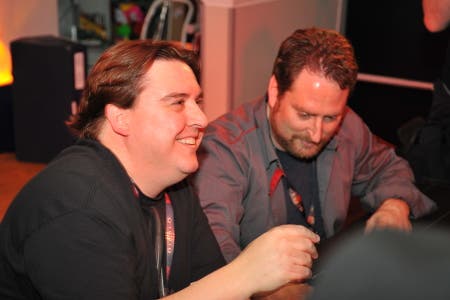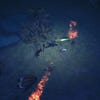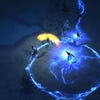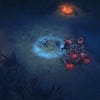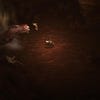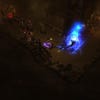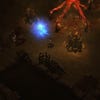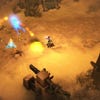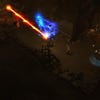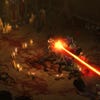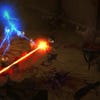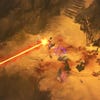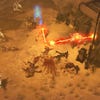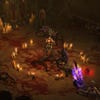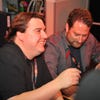Diablo 3: hardcore difficulty, replayability and post-launch plans
We talk to Blizzard about crafting a PC game to last a decade.
At 11pm last night the bell rang out in HMV's flagship store in Oxford Circus. The Diablo 3 servers went live, hundreds of fans roared, and the tills were set alight. The loot hunting had begun.
Today is Diablo 3 launch day, the culmination of a giant effort from Blizzard's Diablo team, which has spent years crafting the follow-up to the 12-year-old Diablo 2. But it is just the beginning. In this interview with Eurogamer, lead technical artist Julian Love and senior world designer Leonard Boyarsky reveal that hardcore difficulty, replayability and post-launch support will ensure Diablo 3 lasts over a decade.
There's so much hype and discussion among fans about Diablo 3. As makers of the game, are you aware of what's going on outside the game, or are you oblivious to it all?
Julian Love: It's got to be both. When you have a fanbase like we have, you'd be silly to not pay attention to it, and even take advantage of it to a certain degree. It's a huge advantage to be able to put portions of your game out into the world and have the fans digest it early in the process, and then give you feedback, which you can take to heart and then use that to guide your way through the process.
But there must be a special kind of pressure making a Blizzard because of the high quality of previous games and the huge expectations of players.
Leonard Boyarsky: As a team we put more pressure on us than anybody else. We just wanted to make sure that what we're putting out there was a great Diablo project, a game that really would deliver what people are looking for in Diablo. For that we have to look to look to ourselves and what we think is going to be that kind of a game.
Diablo 3 has been in development for quite a while. What was the toughest design challenge you faced?
Leonard Boyarsky: For us on the story side, we wanted to infuse more story into it. We wanted more of an emotional depth to the story than the previous Diablo games had had. To that end we put much more dialogue in... not much more dialogue in, because we're delivering it in a different way, but the process of getting dialogue and conversations and lore books into the game that didn't slow down the pace of the game, that really enabled you to keep going with the same Diablo pace, was really a challenge for us.
Our dialogues never seemed to be short enough. We went through several iterations of just making sure they delivered the content we needed but also didn't really impede your play style. It really is this overwhelming feeling of action paced gameplay. So if anything makes it feel like we're stopping that dead in the water, it really ruins the spirit for you - senior world designer Leonard Boyarsky.
Our dialogues never seemed to be short enough. We went through several iterations of just making sure they delivered the content we needed but also didn't really impede your play style. It really is this overwhelming feeling of action paced gameplay. So if anything makes it feel like we're stopping that dead in the water, it really ruins the spirit for you.
My impression from playing the beta is you do pick up the lore books and continue doing what you're doing while you're listening to them.
Leonard Boyarsky: That was our intent. It took us a long time to get that feel right though.
I find you do want to listen to dialogue, but if something is happening in the game that demands your attention, it feels like one side of my brain is trying to listen while the other half is concentrating on staying alive.
Leonard Boyarsky: The best feedback we got was after we did our last iteration of shortening, we put it in front of some people who had been vocal about, I don't care about the story just let me play the game. They said it was short enough and concise enough and delivered in such a way that they wanted to hear it. I'm like, wow, that's a triumph. That's definitely a success. For people who previously said they don't care, just make sure it doesn't get in my way, to saying it was implemented in such a way that it actually piqued their interest, that made us feel really good.
On the technical art side what was the biggest challenge during development?
Julian Love: We had a lot of challenges that go all the way back to when the engine was created. But probably the one that stands out was the direction the skill design took with the runes. We really weren't sure exactly what the rune idea impact was going to be in terms of the amount of work we would have to do, and the amount of variety we would end up putting into the skill system. But somewhere about 2010, it became really obvious we weren't going to be able just plain mechanical differences from rune variant to rune variant. We wanted those things to actually have a graphical variation to them as well.
When that became apparent we did some quick math and we got the number and roughly 750 independent skills we were going to have to build over the next year or so. That seemed like a pretty daunting challenge at the time, and it ended up definitely being a huge issue for us to overcome that - lead technical artist Julian Love.
When that became apparent we did some quick math and we got the number and roughly 750 independent skills we were going to have to build over the next year or so. That seemed like a pretty daunting challenge at the time, and it ended up definitely being a huge issue for us to overcome that.
The game is finished. What is your proudest achievement?
Julian Love: I'd say the team, actually. The one thing I think you'll feel in the game but you just won't see directly is, you know to make a game this good takes a great team, and building a great team is one of the hardest things to do. It's far harder than actually making a great product. To see the team evolve to the point we could make this game and have it come out the way it is, that's pretty gratifying for me.
Based on the beta, there is a feeling that Diablo 3 isn't as punishing as Diablo 2, and some hardcore players feel this is a bad thing.
Julian Love: It depends on what part of the game you're playing!
Leonard Boyarsky: We were erring on the side of caution for a long time. People were saying it was too easy and we were like, no, no, it's not too easy. But then I was talking to Jay [Wilson, lead designer] and he was saying, especially from the beta, it just because evident after a certain amount of time that we needed to make it more difficult.
The upper difficulties were always difficult. Even back before we ramped up the difficulty a little bit, we had people saying, oh my god, this is extremely hard. So it's always been this thing where we wanted a spectrum. We didn't want to just have like one difficulty level.
So regardless of how much we cranked or didn't crank the difficulty in the first part of the game, it still has to progress all the way up to Inferno. We don't want it to feel like you're playing the same thing as Hell as Inferno. So we had to always keep in mind that there was going to be this spectrum that we had to fill all parts of.
If you think about it, this is really a game where there are eight difficulty levels. You can play Normal, and then Nightmare cranks it up, and then Hell cranks and then Inferno cranks it up to insane proportions. And if, for whatever reason, that was too boring for you, all you have to do is hit the Hardcore button and do it all over again - Julian Love.
Julian Love: If you think about it, this is really a game where there are eight difficulty levels. You can play Normal, and then Nightmare cranks it up, and then Hell cranks and then Inferno cranks it up to insane proportions. And if, for whatever reason, that was too boring for you, all you have to do is hit the Hardcore button and do it all over again.
This touches on what must be a tricky design challenge, that is addressing the highly skilled hardcore players at the same time as the vast majority of players, who will probably play on Normal difficulty.
Leonard Boyarsky: A phrase we use around the office a lot is easy to learn, difficult or impossible to master. That's the essence of what we try to get at. Anybody can play Normal difficulty from beginning to end, but once you start getting into the higher difficulties, you really have to start thinking about your character, thinking about the choices you made, maybe even restructuring your character for certain boss fights. It really becomes more of a thinking game when you get into the higher difficulty levels.
We're the developers, but we also have a lot of people on our team who are really die hard Diablo fans and played Diablo 2 to death. So we would look to them and their feedback as well. Even though we're involved in it, we can also look at it and say, okay, this probably doesn't have a high enough difficulty level or is too easy.
What's your best advice for the many players trying to log in today and over the next few days who may struggle to play because of stress on your servers?
Julian Love: Coffee, hot pockets and a wrist brace is my best advice!
Leonard Boyarsky: We have fantastic guys working on that stuff. We have people who've worked on World of Warcraft. It's not like this is our first multiplayer game. I'd put my faith in them.
Do you have a team observing what's happening post launch gathering data?
Julian Love: Since we've been supporting WOW for so long we have a large infrastructure of people who have become experts at supporting a live game like this, and have been through many, many launches with WOW and its expansions. They've built up the best live team. They really know how to take a game live. Our trust is in those folks to do that job.
What happens if a certain class or build emerges that is blatantly overpowered? How will you deal with that post launch?
Julian Love: One thing you have to do is just not launch your game and ignore it. You have to play it yourself and be out there with the community, playing with them and paying attention, because they will write about it and blog about it and all that good stuff. That's a great way. Plus, we have our own stats on our own side where we can tell what's going on.
Part of the fun in some cases of Diablo 2 was it did a good job of making the player feel like they were doing something that they shouldn't be able to do. Like, they were getting away with murder. I know in a lot of those cases those things were intentional. It's part of the magic - Julian Love.
Then, it's also a matter of figuring out whether or not those things are really overpowered or if they're intentional. Part of the fun in some cases of Diablo 2 was it did a good job of making the player feel like they were doing something that they shouldn't be able to do. Like, they were getting away with murder. I know in a lot of those cases those things were intentional. It's part of the magic.
You have a few errant cases where, oh, yeah, that is a bug. And maybe they are getting away with murder, when we need to address it. That stuff will be addressed if it crops up.
People are still playing Diablo 2 over a decade after launch. When you set out to create Diablo 3, did you think of it in the same way? Did you think, we need to make a game that's going to last over a decade?
Julian Love:Yeah. I remember when we sat down early on in the process of just talking about the game years ago, and being in a meeting with Mike Morhaime, and we were talking about servers and stuff, and somebody was asking, well, would we turn off the servers for Diablo 2? His answer was, as long as there are people playing, why would we ever do that?
You could see everybody in the room do a big adjustment. It changed the whole conversation from that point forward. We really had to start thinking about a game that was going to live for a very long time. That underscores from a different angle the idea that replayability is the hallmark of the game in many respects. It's important for us to focus our energies towards that appropriately.
Leonard Boyarsky: We don't just put it out there and then, okay, on to whatever the next thing is going to be. We put it out there, we respond to what's going on and we continue supporting it. That's very helpful in getting something to have a long life as well. But you have to have that mentality going into it. You can't just decide at the end, oh, we're going to do this or that. We're going to continue to have this thing grow. That's something you have to build in from the ground up.
